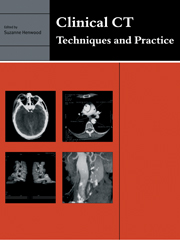CHAPTER 1 - Introduction
Published online by Cambridge University Press: 16 March 2010
Summary
Helical scanning is a means of producing computed tomography (CT) images by combining continuous rotation of the X-ray tube around the patient with a continuously moving couch to produce an integral volume of data. Siemens were the first to market a helical scanner in 1990, quickly followed by the other CT manufacturers, and now all scanners marketed have some level of helical capability. The terms ‘spiral’, ‘helical’ or ‘volume’ are synonymous as far as CT terminology is concerned and vary according to the manufacturer.
There are currently nearly 370 X-ray CT scanners in use in the UK; approximately one scanner per 160 000 of the population. All the CT scanners installed since 1995, and nearly 50% of the total number of scanners, have helical capability.
In 1989, when there were just 200 working scanners in the UK, the National Radiological Protection Board (NRPB) found that CT contributed to 20% of the radiation dose due to medical radiation in diagnostic practice in the UK, although it contributed only 2% of the imaging workload. As well as the above mentioned increase in the number of scanners, the introduction of slip-ring technology has improved the capabilities of X-ray CT scanners, and allowed greater patient throughput, a greater variety of scans, and more types of investigation. It would not be unrealistic therefore to expect that the proportion of the medical radiation dose due to CT has increased.
- Type
- Chapter
- Information
- Clinical CTTechniques and Practice, pp. 1 - 6Publisher: Cambridge University PressPrint publication year: 1999



